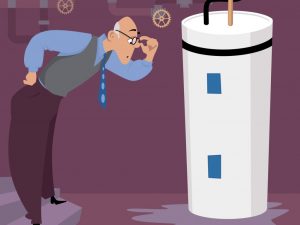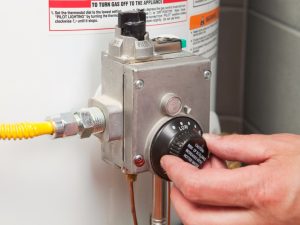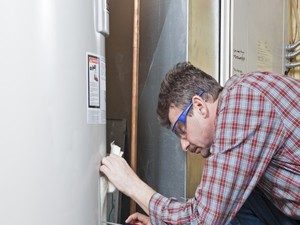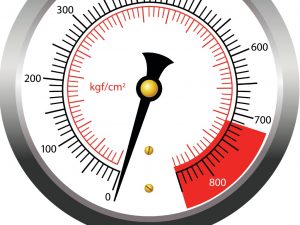On average, homeowners probably don’t give a second thought about the lifespan of a water heater.
That is, until they want to take a nice, warm shower, step inside and chillingly discover that it no longer works.
Depending on the age and condition of your tank, water heater repair may be enough to get it up and running again.
However, there may be certain signs that the lifespan of your water heater is approaching its end.
 Sign #1: There’s no hot water
Sign #1: There’s no hot water
Obviously, the main job of a water heater is to deliver hot water on demand.
When it can’t, it could be due to:
- Corrosion in the dip tube: A pipe that sends cold water to the bottom of the tank where it gets heated.
- Overloaded gas valve: This element sends gas to the pilot light and the main burner; it’s also a safety hazard if it isn’t working properly.
- Compromised electrical elements: The components that actually heat your water courtesy of electrical resistance.
These aren’t simple (or cost-effective) repairs to make.
Your best bet is to ditch your old hot water heater and contact ClimateCare to learn about your options.
 Sign #2: There’s a leak somewhere
Sign #2: There’s a leak somewhere
Leaks are a sure sign the lifespan of a water heater is coming to its conclusion.
These are commonly found in older unmaintained water heaters (around 10-12 years old). If you know there’s a leak but can’t actually find it, it’s usually located:
- In the sidewall seam: Repairing a hot water tank sidewall involves removing the problem area, looking for any damage inside and fabricating a new sidewall piece to install back on.
- At the welded joints: By nature, the weakest parts of a hot water system are the welded joints. Due to regular usage, leaks will start to emerge from these areas.
- Near rusted threads: Over time, the constant exposure to hot and cold water will cause threads to rust.
Unfortunately, none of these issues can be repaired so your tank will need to be replaced outright.
 Sign #3: Gas pilot never stays lit
Sign #3: Gas pilot never stays lit
The gas pilot is kind of a big deal for your water heater.
Without it, the burner inside that tank won’t ignite. In turn, the water inside the tank won’t heat up.
More often than not, the culprit is the thermocouple or gas valve.
The tip of the thermocouple no longer sits inside (around half an inch) the pilot flame. That gap between the flame and the tip prevents the thermocouple from keeping the pilot valve open.
- If the thermocouple is in the right place and the pilot still goes out, there’s something wrong with it.
- If you replace the thermocouple and the pilot goes out, it’s the electromagnet that’s not working (requiring a new gas valve).
Replacing the gas valve (especially if your tank is outside the warranty) isn’t worth the cost.
You’re much better off getting a brand new hot water heater.
 Sign #4: Water doesn’t drain properly
Sign #4: Water doesn’t drain properly
Ongoing maintenance of your hot water tank should include draining the tank once a year to remove sediment build-up.
Neglecting to do this can result in one layer of sediment turning into multiple layers.
Too much sediment destroys the structural integrity of the bottom of the tank.
Finally, the sediment settles between the flame and the water it’s trying to heat. That means the flame needs to burn longer.
If your water tank is so full of sediment that it doesn’t drain anything when you open the valve, it’s a sure sign the lifespan of this water heater is finished.
 Sign #5: No pressure on the hot side of the tank
Sign #5: No pressure on the hot side of the tank
Newer water heaters feature a check valve on the cold inlet side of the tank.
This saves energy by preventing hot water from getting into the cold inlet when the cold side of the tank experiences a drop in pressure.
The main issue with this is the hot side of the tank won’t expand as much as it should.
Going back to elementary school science class, when water is heated, it expands and has to go somewhere.
Those check valves – while handy – limit the expansion capabilities of water. As a result, the hot side of the tank experiences poor pressure.
Is it time for a tankless water heater?
If your tank is exhibiting any of the signs above, it may be time to replace your water heater.
With a tankless water heater, you get the same hot water you’re accustomed to – but at a fraction of the cost.
That’s because tankless units only heat water when you need it. Conventional units heat water continuously, even if you’re not home.
Other benefits include:
- Hot water is available for as long as you need it (don’t worry about using it all up)
- Smaller tankless water heaters take up little space (they can be mounted on a wall)
Of course, there’s no chance of the tank failing (because, well, there’s no tank).
Let ClimateCare help you out
Not sure if the lifespan of your water heater is running out?
Thinking you want to bring a tankless water heater into your home?
Just looking for more information before you make a decision?
Contact your local ClimateCare member today. Tell them what you need to know and they’ll get back ASAP with the answers you need.





